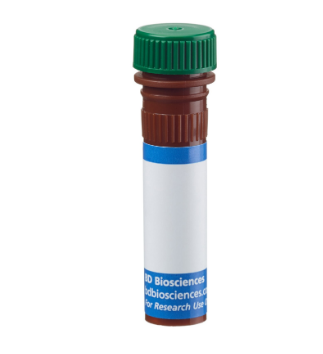FITC Mouse Anti-Human CD8
Clone RPA-T8 (RUO)
BrandBD Pharmingen™
Alternative NameCD8α; CD8A; CD8 alpha; Leu2; MAL; T8; p32
Vol. Per Test20 µl
IsotypeMouse IgG1, κ
ReactivityHuman (QC Testing) Rhesus, Cynomolgus, Baboon (Tested in Development)
ApplicationFlow cytometry (Routinely Tested)
ImmunogenHuman CD8a
Workshop No.IV T171; V T-CD08.03; VI 6T-CD8.1, 6T-081
Entrez Gene ID925
Storage BufferAqueous buffered solution containing BSA and ≤0.09% sodium azide.
Description
The RPA-T8 monoclonal antibody specifically binds to CD8 alpha (CD8α). CD8α is a type I transmembrane glycoprotein and a member of the immunoglobulin superfamily. CD8α is expressed by the majority of thymocytes, by subpopulations of αβ T cells and γδ T cells and by some NK cells. Cell surface CD8α is expressed either as a disulfide-linked homodimer (CD8αα) or as a heterodimer (CD8αβ) when disulfide-bonded to a CD8 beta chain (CD8β). CD8-positive αβ T cells coexpress both CD8αα homodimers and CD8αβ heterodimers whereas some γδ T cells and NK cells express CD8αα homodimers. CD8 plays important roles in T cell activation and selection. The extracellular IgSF domain of CD8α binds to a non-polymorphic determinant on HLA class I molecules (α3 domain) and enables CD8 to function as a co-receptor with MHC class I-restricted TCR during T cell recognition of antigen. The cytoplasmic domain of CD8α associates with Lck, a Src family protein tyrosine kinase that is involved in intracellular signaling. The RPA-T8 and HIT8a monoclonal antibodies are not cross-blocking. This clone has been reported to react with a subset of peripheral blood lymphocytes, but not monocytes nor granuloyctes, of baboon and both rhesus and cynomolgus macaque monkey. In general, a higher frequency of CD8+ and CD4+CD8+ lymphocytes are observed in non-human primates compared to normal human donors.FORMAT
FITC, fluorescein isothiocyanate, is a fluorochrome with a molecular weight of 389 Da. FITC is sensitive to pH changes and photobleaching. Due to nearly identical excitation and emission properties but different spillover characteristics, FITC and Alexa Fluor® 488 cannot be used simultaneously. FITC is relatively dim and should be reserved for highly expressed markers whenever possible.

 010-64814275
010-64814275
 當前位置:
當前位置:



 010-64814275
010-64814275
 010-64814275
010-64814275
 2850669802
2850669802